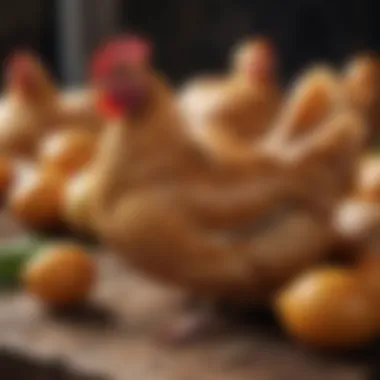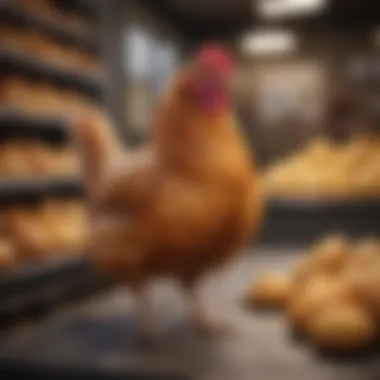A Guide to Sourcing Quality Local Country Chicken


Intro
The journey to acquiring high-quality country chicken involves understanding various aspects that can significantly impact one's purchase decisions. This exploration is not merely about the act of buying; it encompasses an appreciation for the sources, sustainability practices, and the local economy.
Locally sourced country chicken holds a unique appeal for health-conscious consumers and those who advocate for sustainable agricultural practices. Understanding the nuances of sourcing chicken requires familiarity with some key concepts and terminologies that underpin the discussions in this environment. It also warrants a look back at historical practices that have shaped current buying habits. This article aims to be a comprehensive guide for those interested in buying a product that not only meets personal dietary needs but also supports local farmers and sustainable practices.
Key Concepts and Terminology
Basic Definitions
When discussing country chicken, it is vital to clarify what distinguishes it from other poultry options. Country chicken often refers to birds that are raised in more traditional, and often free-range, environments. This method of raising chickens not only influences the flavor and texture of the meat but also carries implications for animal welfare and environmental impacts.
In this context, "local" generally conveys products sourced within a specific geographical area, helping to minimize transportation emissions and supporting local economies. Such sourcing practices often highlight the importance of freshness and the reduced carbon footprint associated with transporting farm products over shorter distances.
Historical Context
Historically, chicken farming has evolved from communal backyard rearing to larger commercial operations. This shift was mostly driven by changing consumer demands and urbanization. However, the recent resurgence in interest towards traditional farming methods reflects a growing awareness of health, sustainability, and ethical concerns around food supply chains. Many modern consumers value not only the nutritional benefits but also knowledge of farming practices behind the products they choose.
Recent Innovations and Trends
Technological Advancements
Recent advancements in agricultural technology have begun to reshape how country chicken is raised and sold. Technologies such as tracing systems and mobile applications provide consumers with essential data about the products they are considering. These tools allow chicken buyers to understand the origin of their meat, the conditions in which the chickens were raised, and even details about how the birds were processed. Such transparency can assure buyers of the quality and ethical standards associated with their food.
Sustainable Practices
Sustainability plays a significant role in contemporary sourcing decisions. Farmers are increasingly adopting practices that not only enhance chicken welfare but also promote the conservation of natural resources. Techniques such as rotational grazing and integrated pest management help in maintaining biodiversity and soil health while ensuring that chickens grow in a manner aligned with traditional practices.
Supporting local farmers through these sustainable practices not only contributes to environmental health but also economies within rural communities.
Practical Applications and Techniques
Step-by-step Guides
When considering where to purchase country chicken, individuals should evaluate several practical steps to ensure their choices align with their values and preferences. One approach involves conducting research on local farms and markets, focusing on their farming practices, beliefs around animal welfare, and consumer transparency. Creating a list of pertinent questions to ask farmers can also aid in this process, guiding one toward discerning high-quality local chicken options.
Case Studies
One notable example can be observed in cooperative farmers’ markets where small-scale farmers come together to sell their products directly to consumers. These markets not only provide fresh chicken and other produce but also enable consumers to engage one-on-one with the farmers, asking about their practices firsthand. Each interaction builds trust, creating a closer connection between producers and consumers.
Understanding Country Chicken
This section delves into the concept of country chicken, providing clarity and comprehension on what it entails. Understanding country chicken is essential for consumers seeking quality poultry as it impacts various factors, such as flavor, texture, and nutritional value. These elements are crucial for individuals who are conscious of the origins of their food and the implications it has on health and local economies.
Defining Country Chicken
Country chicken refers to poultry that is raised predominantly in a natural and rural environment. Commonly, this includes birds raised in free-range conditions, with access to outdoor space, and fed a natural diet. This chicken is often celebrated for its robust flavor, which is attributed to the bird's active lifestyle and varied diet. Consumers looking for country chicken usually prioritize both taste and ethical considerations when choosing their poultry sources.
Differences Between Country Chicken and Factory-Farmed Chicken
When comparing country chicken to factory-farmed chicken, there are significant contrasts that potential buyers should note:
- Living Conditions: Country chickens typically enjoy free-range access, which allows them to roam and forage. In contrast, factory-farmed chickens are often kept in confinement, leading to higher stress levels in the animals.
- Diet: The diet of country chickens consists of natural feed, insects, and plants found in their environment. On the other hand, factory-farmed chickens are generally fed a standardized grain diet, often supplemented with additives.
- Flavor and Texture: Country chicken is noted for its rich flavor and firmer texture, resulting from a natural growth process. Factory-farmed chickens, however, are bred for rapid growth and fattening, which tends to result in a milder taste and softer flesh.
Understanding these differences is crucial for informed purchasing decisions, especially for those who value quality over convenience.
Thus, grasping the definition and distinctions of country chicken versus factory-farmed options will enhance the overall purchasing experience and promote better health outcomes.
Benefits of Buying Local
Purchasing country chicken from local sources offers several advantages that extend beyond merely putting food on the table. Understanding these benefits can empower consumers to make informed choices that positively impact their communities and lifestyles. Engaging in local purchasing promotes sustainability, supports local economies, and enhances the quality of what we consume.
Supporting Local Farmers
Supporting local farmers when buying country chicken is crucial for several reasons. First, it provides economic support to those who contribute to our local food system. Farmers often face challenges such as climate change and market fluctuations, and purchasing directly from them helps them maintain their livelihoods. Furthermore, it fosters a connection between consumers and producers. By engaging with local farmers, individuals can learn about their practices, ensuring they align with personal values, especially regarding animal welfare and environmental sustainability. This direct relationship can also lead to greater transparency in the food supply chain. When consumers know where their food comes from, it builds trust and accountability in food production.
Freshness and Flavor Advantages
The freshness of country chicken sourced locally cannot be overstated. When chicken is sourced from nearby farms, it is often processed closer to the point of sale, leading to a significantly shorter time between the farm and the kitchen. This ensures that the meat is much fresher than that which has been transported over long distances. As a result, the flavor and texture are enhanced, providing a superior culinary experience.
Moreover, local chicken often comes from breeds that are raised traditionally and fed natural diets, creating a richer taste profile. People who appreciate cooking may find that local country chicken can elevate their meals, making it both a flavorful and satisfying choice.
Environmental Impacts of Local Sourcing
Choosing to buy country chicken locally is also beneficial for the environment. The impact of transportation in the food supply chain is substantial. Long-distance shipping of products contributes to increased carbon emissions, which further exacerbates climate change. By sourcing chicken from local farms, consumers can significantly reduce their carbon footprint.
Additionally, local sourcing encourages sustainable farming practices. Many small-scale local farms utilize methods that preserve biodiversity and enhance soil health. These practices can include rotational grazing and organic farming techniques that not only produce healthier livestock but also minimize environmental degradation.
"Buying local not only supports local economies but also nurtures the environment by promoting sustainable practices."


Identifying Sources for Country Chicken
Finding the right sources for country chicken is essential for anyone looking to enjoy high-quality poultry. The essence of this section is to inform consumers about the diverse avenues available to procure country chicken. By understanding where to source this meat, buyers can ensure that they are making informed choices that benefit their health, local economy, and environment. The exploration of various channels reveals the importance of supporting local farmers, obtaining fresh products, and ensuring ethical practices in sourcing.
Farmers’ Markets
Farmers’ markets serve as a prime location for obtaining fresh country chicken. These markets are often local events where farmers and producers sell their products directly to consumers. One of the significant benefits of buying at farmers’ markets is the ability to connect with the producers. Buyers can inquire about the chicken's upbringing and whether it meets personal standards for quality.
Moreover, shopping at farmers’ markets fosters community connections, supports local economies, and reduces the carbon footprint associated with transportation. Families can often find varied chicken options, from standard breeds to heritage types. Adopting this approach not only guarantees freshness but also helps sustain local agriculture.
Online Platforms and Deliveries
With the rise of digital marketplaces, sourcing country chicken online has become increasingly common. Websites such as LocalHarvest.org and Farmbox Direct allow consumers to conveniently order from local farms and have products delivered to their doorstep. This method can be particularly advantageous for those who may not have regular access to farmers’ markets.
Purchasing online typically offers a broad range of options, including whole chickens, cuts, and even processed products. One must ensure that the platform operates directly with farmers to maintain quality and ethical standards. Reading reviews and researching sellers is crucial in ensuring trustworthiness. Consumers are encouraged to look for certifications and information about farming practices provided on these sites.
Local Butchers and Specialty Stores
Local butchers and specialty stores often carry country chicken due to growing consumer demand for higher-quality poultry. These establishments usually have established connections with local farms. By purchasing from local butchers, customers not only acquire fresher products but also contribute to the local economy.
It is advisable to engage with butchers about the sources of their chicken. Most butchers can provide information about the farms they collaborate with, including farming practices and the chicken's life conditions. This transparency can greatly enhance consumer confidence.
Additionally, specialty stores may offer unique flavors and variations not typically found in mainstream grocery stores. These stores often pride themselves on quality and can help educate consumers on the best cooking methods for country chicken.
Assessing Quality of Country Chicken
Evaluating the quality of country chicken is essential for anyone seeking to make informed purchasing decisions. Understanding the aspects that define quality can lead to better health outcomes and more enjoyable culinary experiences. This section discusses the key indicators of freshness and the importance of various certifications relevant to country chicken, providing insights into what consumers should consider when sourcing their meat.
Key Indicators of Freshness
Freshness is one of the most critical indicators in assessing the quality of country chicken. Several factors can determine whether chicken is truly fresh or not.
- Color: Fresh country chicken typically has a pinkish hue. If the chicken appears dull or has a grayish tint, this can be a sign of age or improper handling.
- Texture: A quality chicken should feel firm to the touch. Slimy or sticky textures indicate that the chicken may not be fresh.
- Smell: Relying on smell can be a significant indicator - fresh chicken has a mild, almost neutral scent, while spoiled chicken emits a strong, unpleasant odor.
- Packaging: Checking the package can provide clues. Look for any signs of tears or excessive liquid in the packaging. The presence of liquid can indicate that the chicken has been sitting too long.
Freshness affects not only the flavor but also the nutritional quality and safety of the meat.
Proper handling and storage of country chicken also play essential roles in maintaining its freshness once purchased. Consumers should be conscious of how the chicken is stored and transported to ensure maximum quality.
Importance of Certifications
Certifications can significantly impact consumer trust and quality assurance. Different certifications indicate adherence to specific standards that reassure consumers about the product’s origin and safety. Here are some certifications worth considering:
- Organic Certification: Indicates that the chicken was raised without synthetic pesticides or fertilizers, and is often more flavorful and healthier than non-organic counterparts.
- Animal Welfare Certifications: These include standards such as Certified Humane or Animal Welfare Approved. These labels demonstrate that the chickens were raised in humane conditions, which is important for ethically conscious consumers.
- Local Farm Certifications: Many local producers receive certifications that ensure their products meet specific regional and local farming practices. Supporting these sources often leads to higher quality products.
Finding chicken with these certifications can enhance the assurance of quality, safety, and ethical standards in food sourcing. When sourcing chicken, it is prudent to ask local sellers about their certifications and practices.
Cost Considerations
Cost considerations play a significant role in making informed decisions about purchasing country chicken. Understanding the financial aspects involved can lead to better choices that align with personal values and budgets. In this section, we will explore various elements affecting the cost of country chicken, including price variations and the notion of value versus cost.
Evaluating Price Variations
When looking for country chicken, it is essential to evaluate how prices vary across different sources. Prices can differ significantly between farmers' markets, local butchers, and online platforms. Factors that influence these variations include the rearing methods used, the chicken breed, and even regional differences in supply and demand.
- Farmers' Markets: Here, prices can fluctuate based on the season and the specific farm’s practices. Birds raised on smaller farms may have a higher price due to artisanal methods and direct retailing.
- Local Butchers: These establishments often work closely with local farmers. Thus, their prices might reflect a fair balance between quality and accessibility.
- Online Platforms: Websites such as Facebook Marketplace or other platforms often provide competitive pricing, but shipping costs can add a hidden expense.
Understanding these price variations is essential for budgeting effectively. Always compare prices while keeping in mind factors like freshness and farming practices.
Understanding Value Over Cost
Beyond just looking at the price tag, the concept of value should be central to your purchasing decision. The value pertains to the overall benefit you receive from buying country chicken rather than simply the amount you spend.
- Health Benefits: Country chicken, often raised naturally and sustainably, may offer superior health benefits compared to factory-farmed alternatives.
- Taste and Quality: Many consumers find that country chicken has a richer flavor profile and better texture. Investing in high-quality chicken might elevate your culinary experiences.
- Support for Ethical Practices: Purchasing country chicken can mean supporting farms that use ethical and sustainable practices. This consideration adds intrinsic value that may justify a higher cost.
"The worth of something isn't merely its price; it encompasses health benefits, taste, and ethical considerations."
In sum, weighing these aspects will enable consumers to make choices that align with their values while also ensuring they invest wisely in their food.
The Role of Community Supported Agriculture (CSA)
Community Supported Agriculture, commonly known as CSA, plays a significant role in sourcing country chicken. This model connects consumers directly with local farmers, creating a partnership that benefits both parties. It embodies the notion of community commitment to sustainable and ethical farming practices.
Members of a CSA pay ahead of time for a portion of the farm's produce for a season. This includes a variety of farm fresh items along with country chicken. It encourages consumers to be more invested in their food sources. Joining a CSA fosters a closer relationship between consumers and farmers, allowing individuals to understand the challenges and rewards of farming.
What is CSA?
CSA is an agricultural model in which consumers purchase subscription-based memberships to receive regular deliveries of fresh produce and sometimes meat from local farms. It is a direct-to-consumer approach that allows farmers to secure funding at the beginning of the season. In return, they provide consumers with seasonal produce and farm products throughout the designated period.
Each member typically receives a weekly or bi-weekly box, which may include chicken alongside vegetables, fruits, eggs, or other farm products. This arrangement not only ensures freshness but also supports local agriculture. The model promotes seasonal eating, limiting the environmental impact of transporting goods over long distances.
Benefits of Joining a CSA for Chicken Purchase


Joining a CSA for purchasing chicken offers various benefits:
- Access to Fresh, Local Produce: Members receive chicken directly from the farm, ensuring peak freshness without the time in the supply chain.
- Support for Local Farmers: Members facilitate financial sustainability for local farms, directly contributing to the agricultural economy of their community.
- Transparency in Farming Practices: CSAs often promote transparency about their farming methods. Consumers can learn how the chickens are raised, the feed they receive, and the overall living conditions.
- Nutritional Benefits: Freshly sourced chicken tends to be higher in nutritional value compared to mass-produced alternatives. Members can benefit from richer flavors and healthier options.
- Community Engagement: Participating in a CSA fosters a sense of community among members. It may also include opportunities for events on the farm, cooking classes, and feedback loops between farmers and consumers.
"Community Supported Agriculture empowers consumers to invest in their local food systems and fosters greater awareness of sustainable practices."
- Variety of Products: Membership can also include access to diverse offerings beyond chicken. Occasionally, members could receive unique cuts of meat or specialty items produced by the farm.
- Cost-Effectiveness: Although initial costs might be higher, long-term savings can occur due to lesser food waste. Often, members end up cooking more meals at home, making them more mindful of their food choices.
In summary, CSA represents a promising avenue for those seeking high-quality country chicken, while also fostering sustainable agricultural practices.
Health and Nutrition Aspects
Health and nutrition are critical factors when considering the purchase of country chicken. Understanding the specific attributes of chicken can greatly influence dietary choices. This section will explore the nutritional differences between country chicken and factory-farmed alternatives, as well as the considerations surrounding organic versus non-organic sources. By paying attention to these factors, consumers can make informed decisions that align with their health needs.
Nutritional Differences
Country chicken offers various nutritional advantages compared to factory-farmed options. These differences can be attributed to the chickens' rearing environment and diet.
Key Nutritional Benefits of Country Chicken:
- Higher Omega-3 Fatty Acids: Country chickens often have a diet richer in natural forage, leading to increased omega-3 fatty acids. These are essential for heart health and reducing inflammation.
- Leaner Meat: The exercise that country chickens get from roaming freely results in leaner meat. This means lower fat content overall, making it a healthier option for those monitoring their fat intake.
- Increased Vitamins: Chicken that is raised in a more natural environment typically has higher levels of vitamins, especially vitamin E and beta-carotene. These vitamins contribute to overall well-being and can enhance immune function.
- Better Flavor Profile: Many people report that country chicken has a richer, more robust flavor compared to factory-farmed varieties. Flavor can greatly impact overall satisfaction and culinary experience.
Country chicken’s nutritional benefits contribute to its appeal among health-conscious consumers.
Organic vs Non-Organic Considerations
When evaluating chicken, one key consideration is whether to choose organic or non-organic options. Organic chicken is reared according to specific standards that affect health and nutrition.
Differences in Organic vs Non-Organic Chicken:
- Feed and Antibiotics: Organic chickens are fed organic feed free of GMOs. They are also not given antibiotics or growth hormones, which can be critical for health-conscious consumers.
- Environmental Impact: The farming methods used for organic chicken often emphasize sustainability, which can indirectly affect public health. Supporting organic practices can lead to less pollution, less antibiotic resistance, and a healthier environment overall.
- Nutrition Claims: Studies have shown that organic chicken generally has higher nutrient content. While the differences may seem minor, they can be significant over time.
- Cost Factor: Organic chicken often comes with a higher price tag. Consumers must weigh the nutritional benefits against the cost when making their choices.
"Choosing country chicken is not just about taste; it’s about making a decision that can benefit your health, support humane farming practices, and contribute to a sustainable food system."
Engaging with these considerations helps empower consumers to take charge of their health through informed food choices.
Challenges in Sourcing Country Chicken
Sourcing country chicken can be more complex than many anticipate. it involves various factors that can affect availability, quality, and overall consumer satisfaction. Understanding the challenges faced during this process is important, as they can also open avenues for better purchasing decisions and enhance the overall experience of acquiring chicken.
The appreciation for country chicken comes with its own set of challenges that the buyer must navigate. Knowing these challenges can guide consumers to make informed choices, ensuring their desired quality and sustainability in their purchases.
Availability Issues
One significant hurdle in sourcing country chicken lies in availability. Unlike factory-farmed chickens, country chickens often have limited distribution channels. This can directly influence how often and where consumers can access these products. Factors such as local demand and farming practices play a role in availability.
Local farmers may not have the capacity to meet large demands, especially in areas with a high appreciation for country chicken. Shortages can lead to price fluctuations, making it challenging for consumers to budget their purchases. Additionally, the geographic location can limit sourcing options. Potential buyers might not have farmers’ markets or local farms nearby, constraining their options for fresh, quality chicken. For those interested in sustainability, this can be particularly frustrating.
To mitigate these issues, it's helpful to establish direct connections with farmers or join community-supported agriculture programs. These steps can assure more reliable access to country chicken while supporting local agriculture.
Understanding Seasonal Variations
Seasonal variations also create challenges in sourcing country chicken. Like many agricultural products, the availability of country chicken is influenced by seasonal cycles. Chickens are often raised during specific times of the year, depending on the region and climate. This can lead to periods when sourcing fresh country chicken becomes more difficult.
For example, during colder months, some farmers may decrease their stock due to unfavorable rearing conditions. This can limit the supply available in markets. Conversely, during warmer months, abundance may lead to more options but also raise competition among buyers.
It's crucial for consumers to understand these seasonal dynamics and plan their purchases accordingly. Keeping a calendar of local farming cycles can immensely help in knowing when to purchase country chicken at its freshest. This also contributes to a greater appreciation of the agricultural processes involved in sourcing quality meats.
Understanding the challenges in sourcing country chicken allows consumers to make more thoughtful decisions, fostering a more sustainable and beneficial relationship with local agriculture.
By recognizing both availability issues and seasonal variations, buyers can approach their sourcing endeavors with greater insight. This knowledge empowers consumers to explore alternatives, remain connected with local farmers, and appreciate the importance of sustainably sourced country chicken.
Consumer Trends in Chicken Purchases
In the contemporary marketplace, understanding consumer trends in chicken purchases is increasingly critical. As people become more discerning about their food sources, particularly when it comes to chicken, several trends have emerged. These trends not only reflect changing consumer preferences but also highlight broader issues, such as sustainability and ethical farming practices.
The rising awareness about health and nutrition plays a significant role in the choices consumers make. Many individuals now prioritize high-quality, nutrient-rich foods over quantity. This shift can lead to a growing demand for chicken that is not only free from harmful additives but also sourced from responsible farming operations. Additionally, the increase in health-conscious diets encourages consumers to seek out chicken that is pasture-raised or organic.
Rising Popularity of Heritage Breeds
The resurgence in interest towards heritage breeds signifies a notable shift in consumer taste. Heritage breeds refer to traditional varieties of chickens that have been bred for flavor and robust health over centuries. These chickens tend to have richer flavors compared to typical broiler breeds.
As demand for more flavorful chicken increases, we observe consumers opting for these breeds at farmers' markets and specialty stores. The rise of culinary programs that emphasize traditional cooking methods also fuels this demand. Consumers are no longer satisfied with uniform, mass-produced chicken. Instead, they are looking for diversity in flavor and texture that heritage breeds provide.
Notably, some farmers are adjusting their production methods to accommodate this trend. By promoting these breeds, they not only cater to consumer preferences but also contribute to biodiversity within poultry farming. This can enhance the sustainability of chicken farming practices overall.
The Demand for Ethical Farming Practices
Increasing awareness about the conditions in which farm animals are raised has led to a significant push towards ethical farming practices. Consumers are becoming more educated about the treatment of chickens in large-scale operations. Many now seek out farms committed to humane treatment, better living conditions, and sustainable practices.


This ethical concern translates directly into purchasing behavior. Labels like "cage-free," "free-range," and "pasture-raised" have gained traction among consumers. Many individuals are willing to pay a premium for chicken that aligns with their ethical standards. As such, farmers and retailers must adapt to these expectations to maintain customer loyalty.
A shift towards transparency also augments this trend. Consumers want to know where their food comes from, how it was raised, and what it eats. This demand for information encourages farmers to adopt clear labeling practices. Bridging the gap between consumers and producers fosters trust. Not only does this enhance consumer confidence, but it also encourages the ethical treatment of animals.
Legal Regulations Surrounding Chicken Sales
Understanding the legal regulations surrounding chicken sales is vital for both consumers and producers. In this context, these regulations ensure the quality and safety of the poultry sold while promoting ethical practices within the industry. Knowledge of the laws that govern chicken sales can aid buyers in making informed decisions. It also highlights the responsibility of farmers to adhere to these regulations, ensuring that their practices align with public health standards.
Understanding Local Laws
Local laws pertaining to chicken sales often vary by region. These regulations can include requirements for selling fresh poultry, labeling practices, and rules about how chickens are raised and processed. For example, some areas may require farmers to register their operations and obtain specific permits before selling to consumers or markets. Moreover, the local agricultural department often oversees these regulations.
It's important for consumers to familiarize themselves with these regulations. This helps them ensure they are purchasing chicken from legitimate sources. Those who aim to buy country chicken should not only seek out the best quality but also inquire about the compliance of sellers with local laws. Often, producers who follow the rules proudly display certificates or registrations, indicating a commitment to quality and safety.
Health and Safety Standards
Health and safety standards are critical in chicken production and sales. These standards aim to minimize health risks associated with poultry, such as bacterial infections like Salmonella and Campylobacter. Regulations generally cover aspects of the chicken's life cycle, including feed quality, housing conditions, and sanitary processing methods.
Furthermore, establishments involved in chicken sales must follow guidelines set by organizations. The U.S. Department of Agriculture (USDA) and the Food Safety and Inspection Service (FSIS) enforce strict health and safety protocols. Compliance with these standards benefits consumers by ensuring that the chicken they purchase is safe to eat.
Additionally, many localities may have their own set of health inspections that producers must pass. This ensures that all poultry sold within the area adheres to high standards.
"Knowing the local regulations can empower consumers, ensuring they purchase quality country chicken that meets health safety standards."
Consumers should actively seek information about these standards from sellers. It is wise to ask about the production methods and processing practices of the country chicken they intend to buy. A transparent seller will provide this information willingly, enhancing consumer trust and ensuring a safe purchasing experience.
In summary, understanding the legal landscape surrounding chicken sales provides essential context for buyers. It encourages responsible purchasing and supports sustainable local farming practices.
Sustainability in Poultry Farming
Sustainability in poultry farming is a crucial topic, particularly when discussing the sourcing of country chicken. As consumers become increasingly aware of how their food choices affect the environment, sustainable practices have gained importance. The potential environmental impacts of poultry farming can be significant, hence adopting sustainable methods is not just about ethical consumption but also about preserving our ecosystems. Sustainable poultry farming practices focus on reducing waste, using resources wisely, and ensuring the welfare of animals, which in turn enhances the quality of the meat produced.
Practices Promoting Sustainability
Sustainable poultry farms prioritize various practices that contribute to their overall impact on the planet. Some of these practices include:
- Rotational Grazing: This method allows chickens to graze in different areas at different times. It helps maintain soil health and prevents overgrazing.
- Organic Feed: Utilizing organic grains for chicken feed reduces the risk of chemical contamination in the environment.
- Natural Pest Control: Instead of using harmful pesticides, sustainable farms may employ natural predators or other methods to keep pests at bay.
- Waste Management: Proper handling of chicken waste can turn potential pollutants into valuable compost, enriching soil rather than harming it.
Each of these practices not only supports the health of the environment but also contributes to the quality and taste of country chicken. Choosing poultry sourced from farms that implement these methods can yield healthier, more flavorful products.
Consumer Responsibility and Awareness
As consumers, there is a responsibility to be informed about where and how our food is produced. By actively seeking out sources that utilize sustainable practices, individuals can play a part in promoting environmental stewardship within the poultry industry. Awareness can begin with simple inquiries about sourcing and farming practices from local farmers or retailers.
- Research: Utilize resources like Wikipedia and community forums such as Reddit to gain insight on sustainable poultry practices.
- Support Local Farms: Purchase chicken from local farmers' markets or CSAs (Community Supported Agriculture) that prioritize animal welfare and sustainability.
- Spread the Word: Engage in discussions about the importance of sustainability in poultry farming, encouraging others to consider their food choices seriously.
"Every meal can be a sustainable choice if we support responsible practices in poultry farming."
In summary, when considering where to buy country chicken, awareness of sustainability practices is essential. Not only does it impact the environment, but it also ensures quality and ethical treatment of animals. The power lies in the choices we make as consumers.
Culinary Uses of Country Chicken
Culinary uses of country chicken are crucial in understanding how to incorporate this high-quality product into meals. Country chicken, known for its distinct flavor and texture, serves as a versatile ingredient across numerous cuisines. Cooking with country chicken not only elevates the taste of dishes but also supports local farming practices. Focus on traditional and innovative methods can provide insight into maximizing its potential in culinary applications.
Traditional Recipes Featuring Country Chicken
Several traditional recipes highlight the unique qualities of country chicken. These dishes often showcase regional flavors, cultural origins, and time-honored techniques. Here are some noted recipes:
- Coq au Vin: A classic French dish. Here, country chicken is braised gently in wine, mushrooms, and onions, resulting in a deep, flavorful dish.
- Chicken Adobo: A staple in Filipino cuisine, the chicken is marinated in vinegar and soy sauce. This method ensures tenderness while infusing robust flavors.
- Southern Fried Chicken: This dish focuses on the crispy exterior and juicy interior. Utilizing buttermilk for marination enhances the flavor and tenderness of country chicken.
Cooking these meals provides an authentic taste of culture while emphasizing the richness of country chicken.
Innovative Cooking Techniques
As culinary practices evolve, innovative techniques are being employed to prepare country chicken. These methods not only enhance flavors but also improve the cooking process:
- Sous Vide: Cooking chicken slowly in a water bath ensures its juiciness and maintains the intricate flavors that country chicken brings. It allows precise control over temperature, preventing overcooking.
- Smoking: Utilizing various woods in smoking country chicken adds an intense flavor profile. This method can impart a smokiness that pairs well with many side dishes.
- Marinating: Experimenting with diverse marinades allows cooks to customize flavors. Ingredients such as yogurt, spices, and herbs can bring out the best qualities in country chicken while ensuring moistness.
Consumer Awareness and Education
Consumer awareness and education play a crucial role in the process of buying country chicken. This section illustrates the necessity of understanding the sources and quality of the chicken that consumers choose. Awareness allows individuals to make informed decisions, promoting not only personal health but also overall community welfare. When consumers are educated about the benefits and challenges associated with sourcing country chicken, they can effectively contribute to the demand for higher quality products, influencing local markets positively.
A significant aspect of consumer education is understanding the nutritional value of country chicken compared to factory-farmed alternatives. Knowledge regarding these difference can guide choices towards healthier diets. Additionally, when consumers are aware of how their purchasing decisions impact local farmers and the environment, they are more likely to support sustainable practices. This support extends beyond mere purchases, encouraging local economies and preserving farming traditions.
Resources for Learning about Country Chicken
Educational resources regarding country chicken can take numerous forms. Books, articles, and online platforms can provide valuable insights for consumers. Websites such as Wikipedia or Britannica offer detailed information on chicken breeds and farming practices.
Moreover, local extension offices often have educational materials about poultry farming. These offices can connect consumers with local farmers, offering a direct avenue for learning about their practices and products. Social media platforms like Reddit and Facebook also feature groups dedicated to discussions about local sourcing, where individuals share tips and experiences. These online communities can serve as excellent resources for those interested in purchasing country chicken.
Workshops and Community Events
Attending workshops and community events offers another impactful path for consumer education. These gatherings often feature local farmers and experts who share their knowledge about country chicken production, nutrition, and sustainability practices. Participants get the chance to ask questions, engage in discussions, and deepen their understanding of backyard farming and sourcing.
Local agricultural societies frequently host events that focus on the benefits of buying local chicken. Topics can cover everything from the cooking methods suited for country chicken to the differences in flavor profiles. Engaging in these activities can help consumers develop a network with farmers and other enthusiasts, creating a deeper connection to where their food comes from.
Investing time in these educational opportunities can lead to more informed purchasing decisions, reinforcing the cycle of supporting local agriculture.













